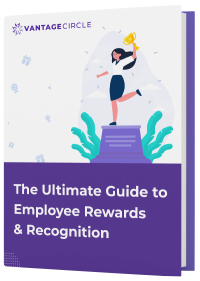6 Steps In Building An Employee Rewards And Recognition Program

Having an employee reward and recognition platform is the single best thing you can do for your company.
According to Globoforce, 83% of HR leaders say that an employee recognition program benefits their company values.
Developing An Employee Rewards And Recognition Program That Actually Works
It's pretty apparent that implementing an employee reward and recognition program for your company should be the need of the hour for you.
So how do you go about building one?
It's not difficult to set up an employee reward and recognition program if you know the right formula. Here's our helpful six-step cheatsheet:
1. Clarify Your Vision
Before you start implementing employee recognition programs, you must be clear about what it involves.
Goals
Be sure about your goals, expectations, and the intended result from the employee rewards and recognition program.
Identify the purpose of implementing the program. Is it to increase the level of employee engagement? Boost sales? Or to establish better company culture?
Once you set your prime goal, it will become a lot easier to build a program that'll work to fulfill your objectives.
Benefits
Research shows the possible benefits that a rewards and recognition program can bring to your company.
A good practice is to look for companies that have already implemented it successfully in the past. Read up on the studies, tips, and ways to maximize the program's efficiency.
Overall, gather a better understanding of how such a program can be aligned to meet your company's goals and needs.
Cost
It's essential to provide a cost estimate to avoid overspending or a negative ROI (including hidden costs).
Even more efficient is to do an intelligent budget allocation. For small companies, estimating the cost of a rewards and recognition program might be more feasible. However, when it comes to mid-sized and large companies, things might turn a tad bit tricky.
Related: The Amazing ROI of Rewards and Recognition In Your Organisation
2. Build A Committee
For the employee rewards and recognition program to be efficiently implemented, the first step is to form a committee.
Regardless of the size of your company, appoint a few people who will be responsible for the implementation, managing, and establishment of reward programs.
A well-chosen committee will assist you in implementing the program efficiently by communicating and reinforcing the R&R program's belief within the entire workforce.
While building a committee, you must keep the following tips in your mind:
- Good knowledge of the program.
- Shows interest in the program.
- Shows leadership initiative.
- Believes in company values.
Once you form the committee, keeping track of employee success, such as work anniversaries, employee birthdays, and promotions, are all excellent occasions to reward and appreciate.
3. Define Clear Characteristics
The next step before executing reward programs is to understand the characteristics that should act as the building block:
Timely
Recognition delayed is recognition denied. Waiting to appreciate top performers only results in the lessening of the impact of recognition when eventually given.
It is considered a good practice to recognize someone as soon as they achieved their goals. Create a culture of appreciation where every small and big employee performance gets rewarded on the spot.
Frequent
Recognition is just like motivation. It is only valid when handed out regularly. Recognition should be a real-time process where no good work should go in vain.
The beauty of an R&R program is the simplicity behind it. It's not about appreciating only the bigger milestones but about the appreciation of the tinier.
Specific
Recognition is more meaningful when distinct accomplishments get celebrated. Being specific means that employees know that a certain amount or kind of performance will bring in praise.
Moreover, it makes people feel that good performance is tied to getting great incentives. It helps establish the belief that you pay attention and appreciate some particular behaviors.
Value-Based
Maybe the most important of any form of recognition aligns with your company values. If your company has a set of deep-rooted values, seek to incorporate the same in the rewards and recognition that you give out to the team members.
Related: 8 Things To Know Before Starting A Reward And Recognition Program
4. Define Clear Criteria
The key to meaningful recognition in the workplace is to set the criteria for getting rewarded and appreciated.
Recognition should be attainable, easy, and convenient for all the workforce. To make rewards and recognition meaningful, you need to decide what form of good work is recognized.
The idea behind creating criteria for recognition is to encourage behaviors that you want to see flourish in your company. Review a series of criteria such as below to find out what suits you best:
What type of behaviors should be rewarded?
Decide what type of behaviors and good work should be rewarded and appreciated based on the values that you are seeking to cultivate in your company.
For example, suppose you are trying to tie productivity to your company's core values. In that case, you can reward behaviors instantly whenever an employee goes above and beyond to get the job done.
How should the said behaviors be rewarded?
It's important to set criteria for how staff recognition should occur and what rewards (for example, gift cards) get offered.
Rewarding desired behaviors set a standard for those particular behaviors to be followed throughout the company.
How often should you recognize your employees?
Recognition is useful when it is frequent in nature. Public praise has the power of being more effective than recognition given in private.
Amplify the effect of recognition given by making it more frequent and timely. Additionally, employees feel better about appreciation coming from their team members rather than their managers.
5. Ensure Successful Implementation
Once you get the necessities out of the way, it's time to make the implementation of the program successful.
Get the employees onboard
The success behind the R&R program lies in how well the program is taken on by the workforce. Make employees aware of the program, use it, the benefits, and encourage them to utilize it on a day-to-day basis.
Additionally, make the program easy to understand and use so that every employee can use it without any problem.
Senior management should advocate it
The supervisors, managers, and senior management should promote the use of the program and subsequently use it frequently. It will help portray a scene where employees take the R&R program seriously because their manager is placing value.
Align it with the company culture
If you want to see positive results, then the surest way to do so is to align the program with the company culture. By doing so, you ensure that not only do you retain your present employees but are also able to attract the top performers.
Related: 33 Rewards and Recognition Ideas to Boost Employee Recognition
6. Measure And Revisit
After the rewards and recognition program gets successfully implemented, your job is still not over.
Measurement
Successful recognition programs are the ones that positively impact the company as a whole, i.e., productivity, business results, and brand value. But without any way to measure it, the effectiveness of the program is unsupported.
Companies employ many methods to measure the after-effects of implementing an employee rewards program. Out of these, the most popular seems to be an employee satisfaction survey program.
An employee satisfaction survey tool is a relatively cost-effective way to gather data from employees themselves about whether their engagement level has improved or not.
Revisit
With changing business demands and employee needs, it seems unfeasible that your rewards and recognition should stay the same. On the contrary, it must regularly evolve and adapt accordingly to meet the requirements of the advancing workforce.
That's why you must regularly revisit the areas of improvement to tailor it to the present-day needs.
Related: The Ultimate Guide to Optimising your Employee Discount Program
Finally
Do you have any thoughts, ideas, or tips regarding building the employee rewards and recognition program? Do tell us in the comments below.

Vantage Circle is a simple AI-powered Rewards & Recognition Platform for upgrading your employee experience and engagement for better productivity.






